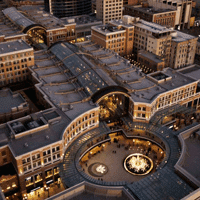Settlement
Although Salt Lake City is a young city, human settlements in the Salt Lake Valley date back thousands of years. The city itself is situated between the towering Wasatch and Oquirrh mountain ranges, across which cut the natural, mineral-rich streams of Millcreek, Emigration Creek, and City Creek, which runs through the city and empties into Utah’s serpentine Jordan River, eventually leading into the Great Salt Lake.
History
In 2003, City Creek Reserve began development of City Creek Center, a sustainable, multiuse, commercial and residential hub that would fill 23 acres of prime downtown real estate. Salt Lake City covers 110.4 square miles, but its downtown district is much more condensed, built surrounding the historic Salt Lake Temple, international headquarters of The Church of Jesus Christ of Latter-day Saints (LDS), and City Creek Reserve is the for-profit arm of the LDS church.
Although the temple is not the oldest structure in Salt Lake City, its completion in 1893—after 40 years of construction—set a lofty precedent for other architecture in the district.
The temple grounds span a range of two city blocks between West Temple Street and North State Street, and right across West South Temple Street were two malls—ZCMI and Crossroads—both of which were built during the 1970s and occupied two adjacent city blocks. City Creek Reserve purchased ZCMI and Crossroads, scheduled them for selective demolition, and began development with The Taubman Company on its new downtown epicenter.

One of the many creeks that flow through Salt Lake City winds through the City Creek Center property.
Rebirth
The first challenge faced by the builders of the new LEED-ND Silver-certified City Creek Center was figuring out what to do with the shells of the ZCMI and Crossroads shopping centers. Linda Wardell, general manager of City Creek Center, says this actually offered an opportunity. “City Creek Reserve, Inc., Taubman’s partners in the project, began by selectively deconstructing the old malls, and in this process we were able to reuse all recyclable materials from the demolition to contribute to the building of the new center.”
The conceptual importance of the location and name of the center was essential to its design. “The center has a 1,200-foot water feature running through it, designed to mirror the actual City Creek,” Wardell says. “It has live aquatic plants and was initially populated with over 200 live trout.” Historically, it was the fresh water of City Creek that led Brigham Young, pioneer of the LDS movement, to declare to his fellow pioneers, “This is the right place.”
Based on its concept, size, and implementation as a central, downtown-revitalization building, City Creek Center uses its most innovative features—low-flow plumbing, automatic lighting and HVAC systems, its retractable roof—to make an equally bold architectural statement, as well as a claim for better communities. Whereas the former properties were exclusively dedicated to commercial use, the new center promotes revitalization by attributing multiple uses to a single project. “Neighborhood development was essential for this project,” Wardell says. “With a dynamic, mixed-use center in place, it will strengthen the business and the economic vitality of downtown Salt Lake City.”
City Creek Reserve designed and funded the entire project and recognized the potential of the center’s proximity to the Salt Lake Temple, the city’s highest-volume tourist destination. Because the project was privately funded at an estimated cost of $1.5 billion, without public subsidy, the construction phase was able to sustain jobs for more than 2,000 subcontractors, who began work in 2006 and built through the midst of the national economic downturn.
The 700,000-square-foot development, which officially opened in March 2012, is the first indoor-outdoor mall of its kind in North America. Its most distinct feature, Wardell says, is the retractable roof. “Aside from a retail center in Dubai, City Creek Center is the only other retail center in the world with a retractable roof,” she says.
Salt Lake City has a semi-arid climate through most of the year. Regulating temperature in the retail center would normally create a substantial drain of energy. The retractable roof allows the center to suspend primary HVAC functions and convert the retail sections of the center to an outdoor mall when the weather allows. “It only takes four minutes to close the roof,” Wardell says. “And when the roof is closed, we have a building-automation system to enable our radiant heating or cooling system to keep the interior comfortable.”
Adjacent to City Creek Center, and elemental to the project, is 2.1 million square feet of existing office space as well as 800 new residential suites, some of which are located above the retail center. Richards Court, which includes two 10-story buildings on the City Creek campus, was certified LEED Gold, aided in part by the project’s neighborhood development scores.
“As part of our responsible messaging for the project, we’ve also developed a concentrated effort to encourage people to access the center through alternate transportation methods, such as bicycling or public transportation,” Wardell says, explaining that the center is immediately accessible via TRAX, Utah’s public transit system, and that bicycle racks are located at all center entrances. “Sustainable building isn’t always budget-friendly, but when we built this center, we knew we were building for the long term. It’s important for the community, the ecology, and the future.”


